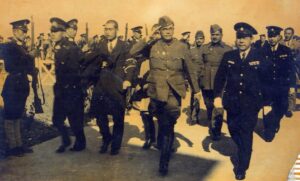Chinese Researchers Claim Netaji Subhash Chandra Bose Was in a Separate Plane During His Death
New Claims by Chinese Researchers Cast Doubt on Netaji Subhash Chandra Bose’s Death
In a controversial new development, Chinese researchers have made surprising claims regarding the death of India’s iconic freedom fighter, Netaji Subhash Chandra Bose. The researchers suggest that Bose was not aboard the plane that crashed in 1945, as previously believed. Instead, they argue that another individual, a man named Gen Shidei, was on a separate plane, casting further mystery over the circumstances surrounding Bose’s death.

Chinese Researchers Claim Netaji Subhash Chandra Bose Was in a Separate Plane During His Death
Netaji Subhash Chandra Bose’s death has been the subject of numerous conspiracy theories and investigative efforts for decades. The latest claims, if verified, could potentially upend the long-accepted narrative of the freedom fighter’s demise, leading to renewed questions and discussions around one of India’s most enduring historical mysteries.
The Traditional Narrative of Netaji’s Death
The widely accepted story of Netaji’s death has been rooted in the crash of a Japanese plane on August 18, 1945. The official version asserts that Bose was aboard the plane when it crashed in Taipei, Taiwan, and he died from the injuries sustained. After the incident, various reports and rumors spread, including claims of Bose being severely burned in the crash. These theories were bolstered by the presence of local Japanese officials who confirmed the crash and death of a prominent Indian leader.
However, since then, doubts about this version have persisted, with several individuals and groups questioning the circumstances of his death. Some believe Bose might have survived the crash and lived in hiding afterward, while others have suggested that his death could have been staged for political reasons.
Chinese Researchers’ New Claims
In a startling revelation, Chinese researchers have now claimed that Bose was not in the ill-fated plane that crashed in Taipei. According to these researchers, General Shidei, a Japanese military officer, was the individual aboard the plane that crashed and died. They suggest that Bose was in a completely separate aircraft at the time of the crash, adding an intriguing layer to the story.
These claims are based on recently declassified documents, archival materials, and research conducted by historians with access to records from that period, including testimonies from Japanese military officials. While no definitive proof has emerged yet to confirm the researchers’ claims, the new evidence has reignited interest in the long-debated issue of Bose’s death.
One of the key assertions made by the Chinese researchers is that Bose may have been purposefully kept away from the crash site, either due to his strategic importance to the Japanese military or as part of a larger political maneuver. Some have speculated that his death was part of a cover-up to protect sensitive wartime information.
Historical Mysteries and Unresolved Questions
The question of Netaji Subhash Chandra Bose’s death remains one of the most contentious and debated topics in Indian history. Over the years, numerous investigations, including government inquiries, have been conducted, but none have provided a definitive answer.
The various reports on Bose’s death, including the Shahnawaz Committee and the Khosla Commission, failed to reach a consensus, fueling skepticism and prompting calls for further investigations. Many individuals, including those within the Indian National Congress, have continued to push for the declassification of more documents in the hope that new revelations could shed light on the truth behind Bose’s death.
Adding to the complexity of the issue, Bose’s disappearance and presumed death came at a time of immense political turmoil. World War II was nearing its end, and the Indian freedom movement was at a crucial juncture. Bose had been a leader of the Azad Hind Fauj (Indian National Army), which sought to overthrow British colonial rule in India. His ties with the Axis powers during the war, particularly with Japan, have only added to the mystery surrounding his fate.
The Ongoing Debate
While Chinese researchers’ new findings have caught the attention of the media, they are not the first to question the official account of Bose’s death. Several Indian scholars, journalists, and researchers have previously proposed alternate theories, including the suggestion that Bose might have escaped to the Soviet Union or even died much later than 1945.
These new claims have raised fresh questions about the authenticity of the evidence supporting Bose’s death in a plane crash. Some analysts argue that the lack of conclusive evidence for his demise has allowed these alternative theories to flourish, feeding into the public’s fascination with unsolved historical mysteries.
The Political and Cultural Impact
The mystery surrounding Netaji’s death has had lasting political and cultural implications. His legacy as a freedom fighter is central to Indian nationalism, and the uncertainty about his final days has fueled a sense of unresolved justice. Many Indians believe that the full truth about his death must be revealed to honor his sacrifices for the country.
The new claims by Chinese researchers, however, add another layer to this complex historical narrative. With ongoing debates over the declassification of documents, the push for a fresh investigation into Bose’s death is expected to intensify. The Indian government’s position on this matter will also play a crucial role in determining whether new revelations can finally close the book on one of India’s most perplexing historical enigmas.
Conclusion
The latest claims by Chinese researchers regarding Netaji Subhash Chandra Bose’s death have reignited interest in one of India’s most enduring mysteries. As fresh evidence emerges, the debate over the true circumstances of his death continues to evolve, with both historical and political implications. While answers remain elusive, the quest for the truth about Bose’s final moments is likely to persist, keeping his legacy alive in the hearts and minds of millions of Indians.
